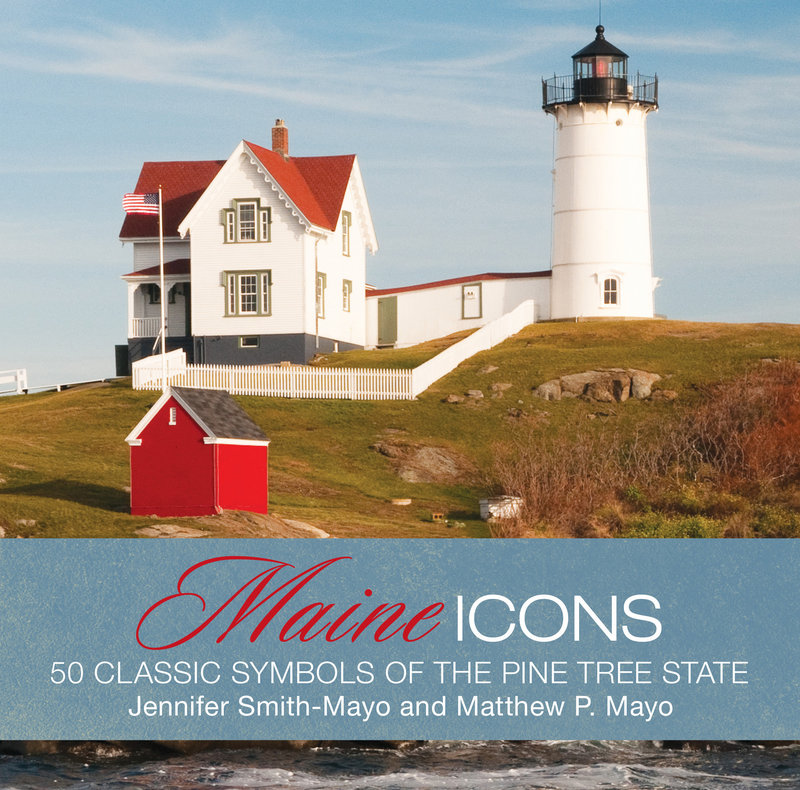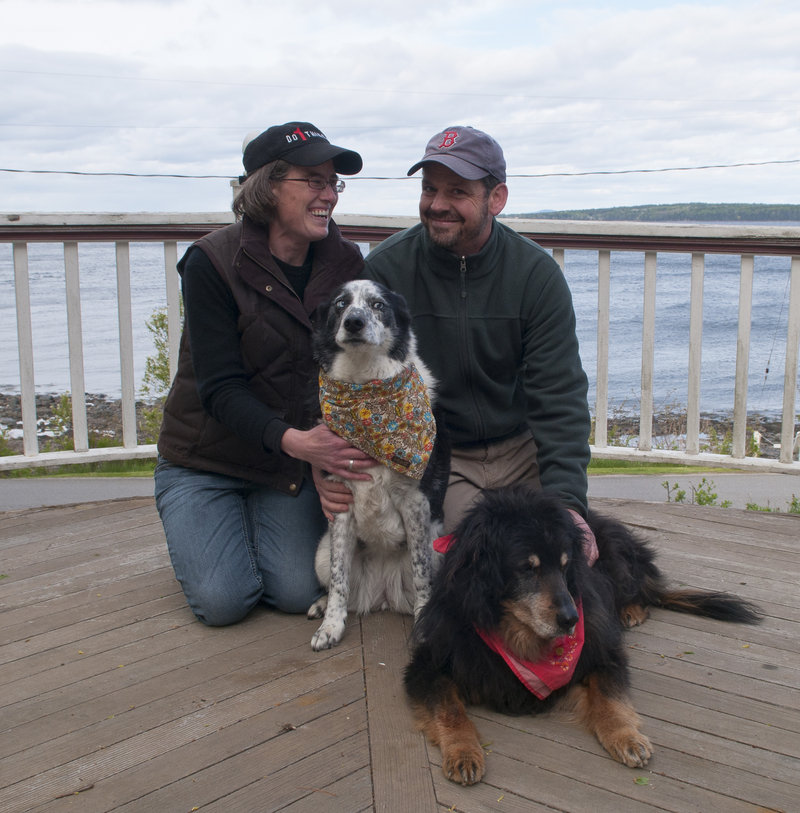If you had to pick 50 iconic images to represent what Maine is all about, what would you choose?
Would you stick to the more obvious candidates, like lobsters and lighthouses? Or would you go with something a little more understated – say, the Wyeth family?
That was the task photographer Jennifer Smith-Mayo and her husband, writer Matthew P. Mayo, faced when they started working on their new book, “Maine Icons: 50 Classic Symbols of the Pine Tree State” (Globe Pequot, $16.95).
Black flies and Moody’s Diner made the cut. So did the Fryeburg Fair and Baxter State Park. Fiddleheads, the white pine and “Uncle Henry’s Swap-and-Sell-It Guide” were all in the running, but had to be (painfully, according to the authors) slashed from the book.
The Mayos have lived in midcoast Maine for 20 years and are now settled in Northport. Jennifer Smith-Mayo’s photographs have appeared in National Geographic, Down East and The New York Times. Matthew Mayo is the author of novels and nonfiction books, including “Bootleggers, Lobstermen & Lumberjacks: Fifty of the Grittiest Moments in the History of Hardscrabble New England.”
The couple has had plenty of time over the years to explore Maine and get to know it well enough to be able to write this book, the first they have worked on together.
“We live on the water and we have a rowboat, so we go out on the bay,” Matthew Mayo said.
“We love hiking,” added Jennifer Smith-Mayo. “We try to hit the state parks. We’ve got quite a few right around here that we go and visit.
“That’s probably one of the nicest things to do because you can stretch your legs, especially Matt. You know, he works a lot at his desk, and having a chance and an opportunity to go hike up the Camden Hills or whatever, it’s just really nice to get out and get some fresh air.”
Q: How did you begin to choose what would go in the book? Did you just sit down and make a list?
MATTHEW: We made a huge list. I think it was 200 to 250, and then we winnowed it down from there. Of course, as with any list, you’re trying to get to the core, and the further you go into that process, the more difficult it gets. And so by the time we got down to say, 75, we were really sweating.
JENNIFER: We would have little arguments.
MATTHEW: There were certainly some that we could have included that I think some people will say, “Well, where’s this and where’s that?” We also left the option open for a follow-up volume, because we think there’s so much more that could be said about the state, so hopefully that might be in the works at some point.
Q: Can you give me an example of something you had to leave out?
MATTHEW: A couple of my favorites, (such as) the Common Ground Fair.
Q: Oh yeah!
MATTHEW: Yeah, I know. (Laughs.) But we did get to mention it in the Bean Hole Beans chapter.
JENNIFER: There’s also a photograph from the Common Ground in the Native American section. We tried to sneak stuff in that you may not know exactly where it’s from, but it helps
MATTHEW: It helps alleviate our guilt. And also, Liberty Tool is another one.
JENNIFER: Oh, yes. And the outhouse, the three-story outhouse (at the Masonic Lodge in Bryant Pond).
MATTHEW: Some of them, you wonder if they’re iconic or not, or are they just cool and weird. But maybe that’s a whole other book.
Q: I like the fact that you included things like fog and the Big Chicken Barn.
MATTHEW: Yeah. I love the more esoteric chapters. They were a lot of fun to write. A real challenge. But I think it came out OK, and Jen’s photos are beautiful.
Q: Did you have any criteria for calling something an icon? What made something a Maine icon?
MATTHEW: I think we do have some sort of definition, and maybe even wrote it down somewhere. I don’t remember specifically what it was, but some of them just seemed so obvious. There’s blueberries, lighthouses, that sort of thing, where we said that’s iconic for sure, so we just go from there. And as you build the list, you add to it and there are things that are a little less obvious, but when people read them, they say, “Oh, of course.” To me, Stephen King, because I’m a fan of his writing, and I think including him was kind of fun. And a lot of people might be surprised by that, but he’s a huge proponent of all things Maine, so why not?
JENNIFER: Some of the historic chapters as well, like Bath Iron Works and Chester Greenwood. Those two iconic chapters really help define Maine. I think that’s a big piece of it: What helps define the state?
MATTHEW: Joshua Chamberlain, the type of man he was, the fact that he was a Mainer and he did all these amazing things in his life and he just never gave up. That attitude, that can-do spirit, seems so very Maine, so iconic.
Q: If I were doing this book, it would be frustrating to me. I’d think, “Oh, I have to do lobsters and blueberries” – the things that are really obvious – when maybe you might want to do more of the less well-known things, like the Kenduskeag Stream canoe race. Did you feel that way?
MATTHEW: To be honest, I never really did, only because I looked at each one as a challenge. And when researching them, I tried to find all these crazy facts, these obscure facts, that I could jam in there that people would read it, and as they were reading it they might raise their eyebrows and say, “Wow, I had no idea about lobsters. I didn’t know that this happened or that happened.” That was the fun challenge of it for me.
JENNIFER: I tried to give everything a little bit of a different viewpoint. I shot things in more of what you might call a documentary style to give you maybe another layer, another level of understanding of the state, and also fun. I tried to find some fun moments, like the “summercators” chapter with the young lad who’s jumping off the dock. That’s just a fun moment.
MATTHEW: It captures summer on the coast of Maine pretty well, I think.
Q: And the guy with his face in the blueberry pie.
MATTHEW: Yeah, absolutely. Or our friends in the black flies chapter. Those are some friends of ours, and that’s how they garden, with the full bug suits.
Q: Are there any fun facts you didn’t know about before that really stuck with you?
MATTHEW: I knew a little bit about Joshua Chamberlain, but in researching him, I didn’t realize the extent of all the amazing things he did in his life. What’s the last sentence of the chapter? “He died in 1914, fifty years after the Civil War, at the age of eighty-five – the last Civil War veteran to die of wounds sustained during the war.” He suffered on a daily basis from those wounds, for 50 years. And yet he still served the state and the country, held all sorts of political offices, was the president of Bowdoin College for 12 years. He was just an amazing man.
Q: What’s your next project? Are you doing something else together?
JENNIFER: We are. We’re working on Vermont icons and also New Hampshire icons.
MATTHEW: And then we have a couple more projects in the hopper for the editor, and they look promising, but it’s nothing we can really talk about right now. And then I have a few more nonfiction books lined up, and novels as well. And Jen’s shooting for Down East and for the books.
JENNIFER: I leave next week to go on a long shoot, and hopefully Matt will be able to join me at some point, and we’ll hike part of the Green Mountain trail system and have some fun exploring Vermont and New Hampshire.
MATTHEW: But it’s difficult to leave Maine in summer, because it’s beautiful here.
Staff Writer Meredith Goad can be contacted at 791-6332 or at: mgoad@pressherald.com
Send questions/comments to the editors.





Success. Please wait for the page to reload. If the page does not reload within 5 seconds, please refresh the page.
Enter your email and password to access comments.
Hi, to comment on stories you must . This profile is in addition to your subscription and website login.
Already have a commenting profile? .
Invalid username/password.
Please check your email to confirm and complete your registration.
Only subscribers are eligible to post comments. Please subscribe or login first for digital access. Here’s why.
Use the form below to reset your password. When you've submitted your account email, we will send an email with a reset code.